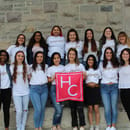The Instagram aesthetic has fully taken over. From ads to activism and everything in between, it’s obvious that the theme has made its mark on our generation; however, it may be more misleading than you think. Last summer, everyone’s feeds were flooded with pastel infographics trying to educate followers on the importance of topics like Black Lives Matter, gun violence and women’s equality, but also an influx on human trafficking. #Savethechildren went viral. Ranging from influencers with hundreds of thousands of followers to your neighbor with just 50, infographics with false statistics flooded our feeds. Many had the best interest in mind, yet failed to realize that the campaign had one job in mind: spreading the false conspiracy theories.
QAnon, born in right-wing extremist chat rooms, has spread like wildfire throughout the pandemic. Plainly put, its outlandish beliefs state that democrats and powerful elites kidnap and traffic children in order to drink their blood and get high. They think this because an anonymous person online, who claims to have a Q level security clearance, is working alongside president Donald Trump to overthrow their said evil club. Ultimately, though social media marketing tactics, they’ve gained the ability to break through to the mainstream and wreak pure unadulterated havoc.
In order to push this narrative, QAnon had to target all lenses, including targeting young women. This led to an influx of pastel-laden infographics that rebranded the QAnon aesthetic for a new audience.
To combat this, social media companies have pushed for the removal of these posts, but are ultimately imperfect in their execution; therefore, the consumer is left responsible for what they take in. When you’re looking through your feed it’s important to ask yourself these questions:
- What is the source?
-
If the post doesn’t credibly back up its facts, then you should take a moment to reassess.
- Who is sharing this information?
-
Check the account that posted the graphic. If they have an obvious bias, it may not be factual.
- Most importantly: Are mainstream media sources reporting the same?
-
If you see a wild claim being uplifted, it’s important to check if mainstream sources are saying the same. Check the New York Times, The Washington Post, or any other source that has mainstream credibility. If they aren’t corroborating, it’s probably not true.
Altogether, smart consumption of media is vital for the preservation of our democracy. So, take up the responsibility and work to fight against dangerous disinformation before it’s too late.



